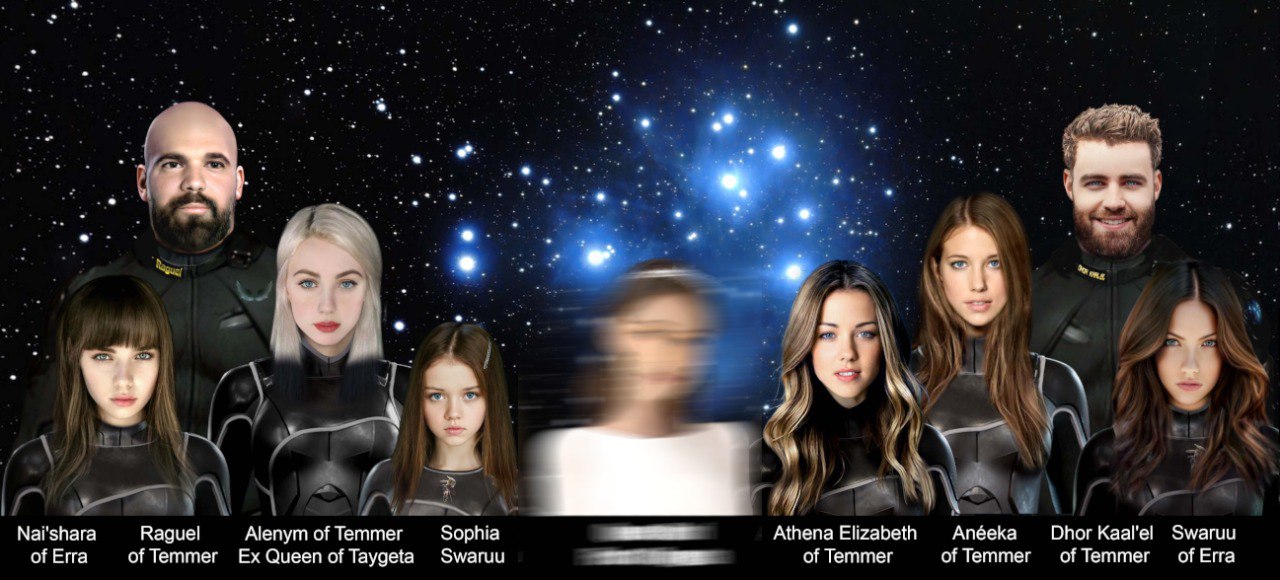CYNDRIEL - ALDEBARAN **NO VIDEO**
THESE TRANSCRIPTS CAN BE ACCESSED TO MAKE TRANSLATIONS INTO ANY LANGUAGE (in text or video) ONLY WHEN THEY ARE ACCOMPANIED WITH THE OFFICIAL CREDIT TO THIS WEB PAGE AND OUR YOUTUBE CHANNELS WHERE THEY WERE FOUND.
Under no circumstances is it allowed to publish the information presented in our channels and on this page for commercial purposes (sale of books and promotional materials).
Author
ATTACHE, englishPublished
November 21, 2021CYNDRIEL - ALDEBARAN **NO VIDEO**
Anéeka: Cyndriel is a Class M planet, with a pleasant average temperature towards the higher ones. That is, it is very hot there, comparable to the Gobi or the Sahara on Earth with rocky mountain areas like the mountains of Colorado.
The entire planet is almost all desert with a lot of subterranean water. It is not scarce or only scarce at the surface. It does have multiple large lakes though. It has a lot of desert wildlife. It is full of exotic life as well as exotic plants.
Gravity is 0.7g. Earth base 1.0g. High oxygen, about 80%. It is toxic if you do not acclimatize first when coming from Earth, but not from Temmer which also has it high. Even so, Cyndriel is considered a planet close to being one of the so-called super habitable planets like Temmer and Erra. Planets where it is easier to live than on Earth. Planets that favor life more than on Earth. Alfrata is another very habitable one as well as Venus which is not a bunch of hot gas, it is beautiful and habitable.
Cyndriel is close to the large orange, ringed giant Aldebaran which has a nebula around it as well. Aldebaran is part of the Hyades. It is, to the best of my memory, 64.5 light years from Earth. While the Pleiades is at 440, average to Taygeta.
It's just that in two planes they look close, but if you see them in three planes they are far away like Orion also because two of the Orion stars are the ones that are closest, whereas the one in the center is the farthest from the other two. Please watch this, it's only three minutes, but it will give you an overview of how things look from the perspective of someone in a spacecraft like this one. You will see how I think about where what is what in space around the Pleiades. You will understand us better. Star map (showing a video).
Back to Cyndriel, the rings of the star Aldebaran are not like those of Saturn.
Saturn's are too big in relation to the sphere. The rings are something like in this image or a little smaller even. Closer up and just the inner ring. I understand that the rings are made of metallic rocks.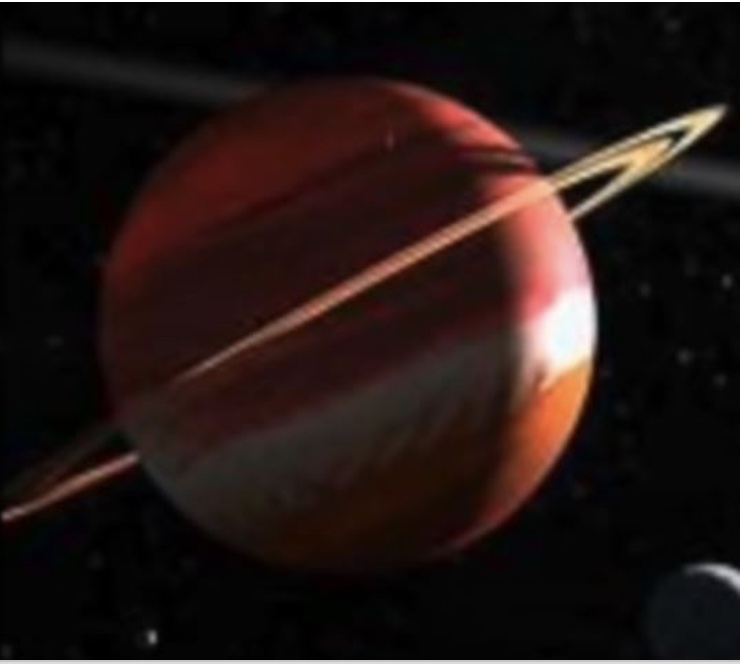
The nebula enveloping Aldebaran is mostly white gas and dust that takes on the orange-red reflective color of the star. Unlike the Pleiades nebula, Aldebaran's nebula almost exclusively envelops the large star making it appear even larger. But it is not a uniform haze as in the case of the M45 nebula, it looks like streams or streaks of higher density. It gives a dreamy feel to all of Aldebaran and the Pleiades as well, of course.
The Aldebaran solar system, to the best of my memory, has three small Earth or M-type planets of which only one is inhabited, Cyndriel. And two super giant planets, one the size of Jupiter and one the size of Neptune in outlying outer orbits. That is, the three small rocky ones are close to Aldebaran, being that the first two are too close and only Cyndriel, planet number three, is in habitable conditions. These two are not habitable basically because of too much radiation. As with Mercury here, there is nothing there but rocks.
The two super giant planets, on the other hand, have inhabitants, animals of the type similar to those found on Jupiter, Saturn, Uranus and Neptune. They have no surface, only gas that becomes progressively denser and denser without a defined surface.
So, Aldebaran has a system of five large planets and countless small planetoids and asteroids orbiting it in a wide outer belt away from that sun in a Kuiper band fashion for Earth as an equivalent. As for names, I don't have them at the moment. All my Aldebaran attention has been focused on Cyndriel and the Great Sun, of course.
Regarding Aldebaran's star, it is not very transited. Not as in transit because of its spots. What happens is that it is a very powerful star, it emits a lot of radiation and makes it difficult to handle compared to a yellow sun. It emits too much energy, overloads the ships, makes it dangerous. It is simply too big and it is unnecessary to operate such a star if you have the option of using normal minor stars.
Aldebaran is indeed in a strategic location, but with the Hyades there you use those yellow suns as a transit system, leaving aside the powerful and therefore difficult star Aldebaran.
The giant has a much smaller companion star, Aldebaran B. Although it differs greatly in size, it can be said that it is a binary or more or less binary system.
Aldebaran B is a small red dwarf and the difference between a red dwarf and an orange giant is abysmal. It is a binary system, but not as in there is another Aldebaran that big.
Regarding the planet Cyndriel, Taygeta has had a large colony there for a long time. The area is very special because it is very mystical. In itself, Cyndriel is very exotic to the Taygetan mind. And many people report paranormal and consciousness altering events and experiences in the area and in Cyndriel. Many Taygetans go there to live looking for existential answers and for esoteric experiences. In itself, Aldebaran, by itself, is highly hypnotic as a sun or star.
Also the time there alters enormously, there being a huge difference in the perception of the passage of time on the surface than in orbit. This is rare and unusual for a planet. It is not yet known what or why it happens. It has something to do with the enveloping nebula and Aldebaran itself, its proximity.
From Cyndriel's surface, and from orbit even more so, Aldebaran is intimidating because of its sheer size and rings. It feels like it will burn you for having the sun so close, but the nebula itself filters much of Aldebaran allowing Cyndriel to not be under impossible temperatures even with its proximity to Aldebaran, still its influence is great.
When dawn breaks or when the sun sets, it dominates the entire horizon with a soft orange glow and its prominent rings glowing chrome or silver. Truly a very alien scene. There are no words to express what it is like to be there in Cyndriel. It has been said that it resembles "Tatoonie", Luke Skywalker's planet from Star Wars, but no, it doesn't, no. There is simply no comparison.
Cyndriel is a dream. It's a metaphysical place. Over the top. It fills your senses. Bordering on the bizarre, on the psychedelic. Really, I'm not exaggerating. Everything there is just unreal. I was there in 2016 just before I arrived here in March 2016. The Ventra ship that I was crew of as a cadet made a stop there.
But for me, it hit me very hard because it was the first exo solar system outside of Taygeta that I have seen and absolutely incomparable, completely alien, so much so that it is scary. I was also scared because I didn't understand anything. I couldn't see anything familiar unless I was there inside the Taygeta bases. But outside nothing was familiar, but nothing.
And that sun is really wordless, intimidating. That orange ball in a haze of nebula and still with those silver rings, yet it dominates everything. It's not like a sun on Earth or Taygeta. At noon 90% of Cyndriel's sky is Aldebaran and you really feel like it's going to burn you. You don't understand why it doesn't burn you being so close.
Another thing, there is no night there, it just gets a little dark and space or stars are barely visible. It is blurred or covered by the nebula that is illuminated all the time. If astronomy with a telescope is what interests you, Cyndriel is not the place for you.
Also, the time there is hard to calculate, but what I felt is that I was there for about a week and I was even relieved to see that the ship had jumped back into Hyperspace. Look at the size difference with Sol 13 and Taygeta. This picture does not do it justice. The sun dominates everything.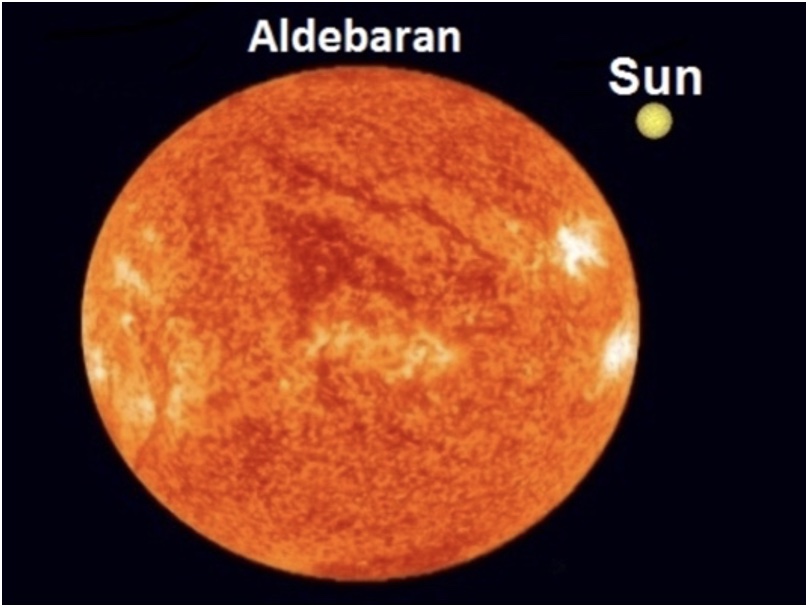
BIOLOGICAL DYNAMICS AND NATIVE POPULATION
As I was saying, everything in Cyndriel is unfamiliar. Everything is huge. It gives you the feeling of being very small and insignificant. Everything is threatening. More so because you don't know it. Everything threatens you in Cyndriel. Everything looks dangerous. Every plant and every animal looks like it could do something to you, more so with its exaggerated colors with lots of yellow, red and orange. For example, in Taygeta as well as on Earth, they indicate poison. The plants are strange, some transparent, also with red instead of green. All the plants are dominated by shades of red.
The stones and mountains are huge and without slopes, like over you about to fall down and just huge. Side stones, as in this image, also dominate a lot in Cyndriel.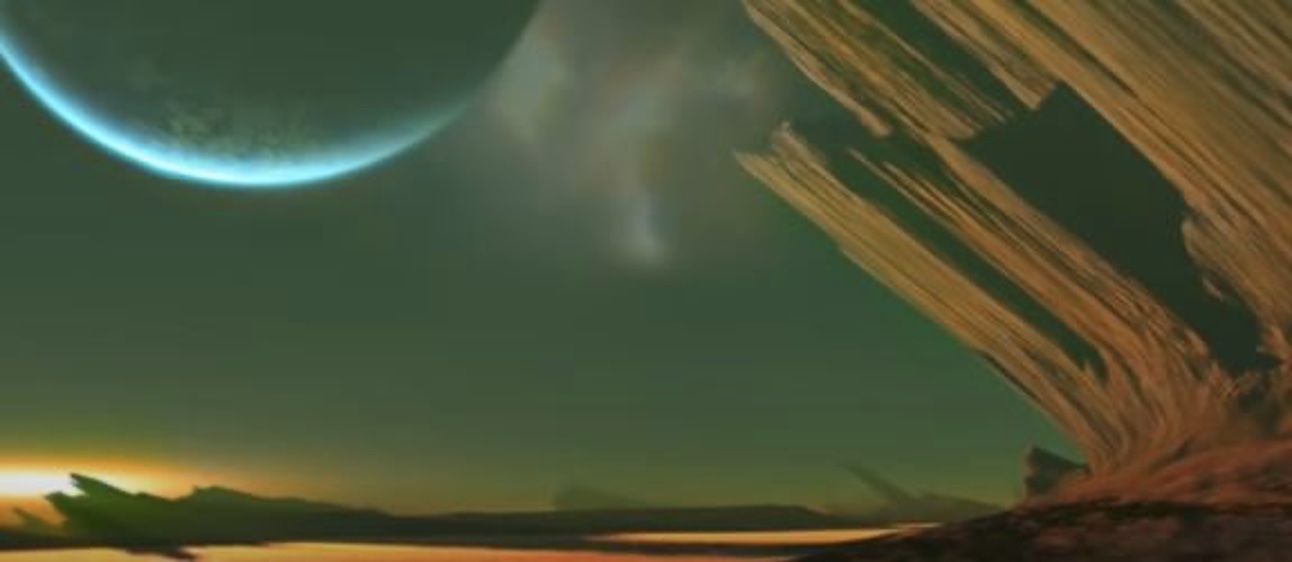
That feeling of uselessness, of being in constant danger, of not being able to hide from anything, overwhelms you and, at the same time, Cyndriel's reality is that everything there is benign, everything is friendly, nothing hurts you. It is only your own mind, your ignorance, that sees danger in everything. Nothing there can hurt you more than what is logical.
Also, time there alters enormously, there being a huge difference in the perception of the passage of time on the surface than in orbit. Time, from a point of view like someone on the surface, let's say, looking at plants and the landscape, feels the same as from the surface of any other planet or spacecraft. But that is relative to each person as it is the person himself that is generating that perception of time. That is the reason why it feels or is perceived the same. The problem is that, relative to another point, surface versus orbit, there can be a big difference that could only be reliably measured with two clocks.
TOPOGRAPHY AND CLIMATE
As far as I saw, I do not know if it is like this all over the planet, it does not have so much density of plants. It is more sparse as a desert and almost the entire surface is rugged in terms of topography with few plains, all high rock. The rocks are like that because of wind erosion.
The whole planet is desert because of the direct influence of radiation. There is also a lot of wind, abundant sandstorms and whirlwinds. That is why most of the infrastructure of the planet in the form of cities and facilities are located below the surface.
The temperature is pleasant between 25 to 35 degrees Celsius on average, of course. There are warmer and colder areas. For example, you can also find frozen places from minus 80 degrees to over 50 degrees in desert areas at extreme points.
As I was saying, Cyndriel surprises because everything seems very hostile there, being very benevolent. It seems that everything wants to kill or hurt you, when nothing hurts you there, only the obvious, of course. Even the thorny or pointed plants are very soft. They melt in your fingers. They do not hurt you.
So, Cyndriel as a base or colony is a touristy place, let's say, using human terms. Everybody wants to visit it. Also because of the mystical experiences it produces. The fact that there is no night does have an effect, so much so that the flora and fauna is very native. That is to say, it shares little with other places because it needs to be in accordance with the cycles that are few. As I was saying, in Cyndriel there is only sun or shadow, never darkness. So, the organisms are special to that place, adapted to not having night.
The living organisms there are characterized in that they need much less exposure to solar radiation than here or in Erra or Temmer. So, they are not very sensitive because they have a lot of sun. That makes the photosynthesis processes slower and the plant is more protected from radiation rather than looking for radiation as plants do on Earth. This gives the plants there their distinctive red or orange-yellow color in contrast to the green of Erra, Temmer or Earth.
The animals are also adapted to a lot of sun with very thick or scaly armor or skin especially on the back, on top. And plant-eaters abound there because the plants are especially nutritious. For example, there are little lizards everywhere with scales on their backs and they are plant-eaters, they eat roots and seeds.
You don't find animals or plants that are on other planets far away. That is, for example, on Erra there are rabbits and hares, the same ones as on Earth, but on Cyndriel there is nothing similar, that's why it is so exotic. And, at the same time, as it is not dangerous, it lends itself perfectly to travel, because it gives the experience of being on a planet very different from yours, because in itself, Erra or Temmer is very similar to Earth. When you take a picture of it, they blend in among so many other similar super habitable planets. But not Cyndriel. It is unmistakably an alien world.
PLANT KINGDOM
In plants, red dominates. It is red photosynthesis. It is curious because in itself, red and green are related as colors, that's why color-blind people do not distinguish them, so it is only photosynthesis. It just adapted to red because of the influence of Aldebaran, since the influence of Aldebaran causes photosynthesis to be red, because it obeys specific frequencies where that wavelength is the most efficient for cellular processes.
The plants there are hanging cactus-like with long, razor-like succulent leaves, but transparent with a reddish hue with their sap ducts also visible in red like blood vessels.
In Cyndriel a huge percentage of the plants are transparent or semi-transparent like aloe leaves but in red, and without the shell, only the transparent interior. This form dominates in the plants. Some plants are similar to this image. This color inside. It just lacks the transparency as if it were only a protective membrane on the outside.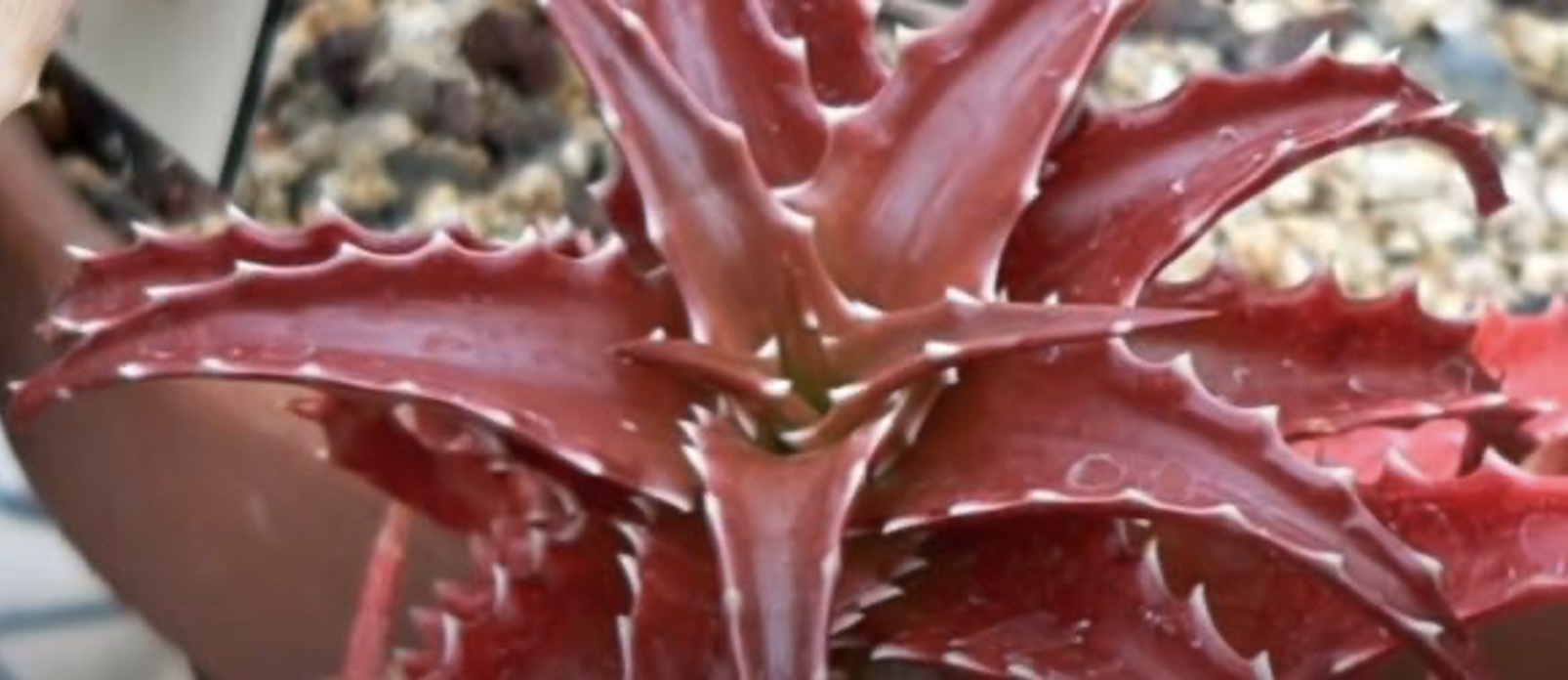
What I have been told is that the plants are like that because they have adapted to defend themselves from the excessive Aldebaran radiation by adopting their shape to be transparent so that the rays, the radiation, go through them and do not stay in them. An adaptation to certain wavelengths of Aldebaran radiation.
Radiation is transformed by the planets. They are not inert. They do it with their own electromagnetic field, magnetosphere. And with their atmosphere which, in turn, is altered and shaped by the interaction of their living beings, be they plants or animals. Although plants have more direct influence.
Moving on to stranger things about Cyndriel, there is a kind of long-leafed cactus like what would be a maguey plant, as it is known in Mexico, with that name, I don't know if there is another one for the same plant, that grows from a nucleus. It looks like that but in red and orange colors with violet tips, but on the top and the bottom equally, and tends to float in the air at low altitude, no more than three or four meters.
It is not due to gas. It is because of some anti-gravitational property it has. I don't have the answer how or why, but they are sort of in clusters together and the wind moves them all over the area. They throw spore into the lakes and there they grow floating. As they mature, they float out of the water. What makes them float is something they got in the nucleus. The one who would possibly know the most about the how is Yazhi Swaruu. It's one of the strangest things I've ever seen.
ANIMAL KINGDOM
In Cyndriel, the animals have very reddish to brownish skin in the form of scales like shields, but there are few animals on the surface. The animals generally seek the shade of large rocks. What dominates in Cyndriel in terms of animals are small reptiles. This is the largest population. Small reptiles abound in the form of iguanas and lizards. No larger than a meter. Again, transparent reddish. You can see their internal organs like some cave salamanders on Earth.
There are also amphibians. Compared to Taygeta, where bird species abound, in Cyndriel they are almost completely absent. The birds are all orange as camouflage. This makes them rare to observe. There is no species that is not orange or a very uniform yellow or rust red variant.
Regarding mammals, small rat-like mammals abound. Long-legged desert-like with long anteater-like faces, as they use them for the same purpose since they are mainly insectivorous. Few large animals. None the size of a cow or horse. All smaller.
There are also other species there which I don't know how to catalog because they are neither reptiles nor mammals. Biologically they are related to plants. They look like big rodents, but they are plants. Very intelligent. Very mobile. Like a kind of porcupine with a flattened carapace of scales that resembles a turtle, but without being rigid, and that eats algae and that green slime that covers the lakes. They are brown in color. About the size of a large house cat.
They look more like animals. They don't look like plants per se, but their genetics are. Their cellular structure is that of a vegetable. Their scaly skin, shell, produces photosynthesis like our skin produces Vitamin D. They have veins with blood, but it is different. It's like that of an alien, green blood. They have nails, but no teeth. They have like filters in their mouths like a duck's beak that they use to filter solids from the water and eat that. And they have eyes, but they look black. Also kind of similar to the grey races. Also with sort of sunglasses because of the aggressive Aldebaran, although not as much as we would expect, as I said. That is, they have almond-shaped eyes and inside all black like with an extra layer of sunglasses built in in addition to the eyelids.
Their molecular genetics, their organism and their metabolism is plant not animal. Just like the Grays of Zeta Retículi. They are plants. This is not entirely unknown since the Grays, the gray ET´s, those classic ones, of the 165 known species of them, more than half are plants as well. To the extent that the Americans, at the Wright Patterson base, where they took the Roswell alien, named EBE-1, when he began to get sick around 1955 and finally died, had to seek the help from experts in botany.
Going back to Cyndriel's animal species, there are also reptile-hybrid mammals that are actually neither. They suckle, but hatch from eggs like platypus dinosaurs. Like a platypus, but flattened and larger than the size of a llama, but shaped like a camel with a beak. It is semi-aquatic like a hippopotamus would be.
And in Cyndriel it means that it is semi-subterranean since, as I told you, it has many lakes, but most of them are in the shade or they would evaporate, since the surface is like big porous like gruyere cheese. That is to say that in the semi-intraterrestrial hollows there are lakes and it is there where life boils mostly.
But consider that the mountain is porous, made of pure rounded cavities with rounded pillars that support the structures above and the sun entering through the multiple cavities and lakes full of red plants and animals below.
The outside lakes are very salty, concentrated. Animals tend to avoid them, as a rule. But there are plants of the Succulent Cactaceae type all around. All in red colors.
Some reptilian mammal hybrids look like dogs with scales and lizard faces. They look dangerous and are fast and make ugly intimidating sounds, but do no harm, they are plant-eaters. They lay eggs, but they suckle. Needless to say, the platypus is not terrestrial.
In the water there are also many species of invertebrate mollusks. In the water, below. Cousins of octopus and squid, but freshwater. Although, as I said before, many lakes are salty. And there is also a countless variety of flying insects.
But something important to note here is that there are no plant or animal species that Cyndriel shares with other planets. As shared by Alfrata, Erra, Temmer, Earth, Pitoya, among others. That is why it is a tourist destination, because of the alien experience it offers. You will not come across any of the common hares that abound in so many places.
Everything you look at is unrecognizable and originally from there. Yes, there are physical similarities, but they are not the same species. For example, plants mostly have leaves and animals mostly have four legs and a head. These seem to be universal constants, but that's as far as the similarities go. Although we could always classify them as something known as a species of mammal or oviparous or succulent plant, but it would only go so far.
INDIGENOUS POPULATION
Cyndriel has a native population. It has a number of energetic beings that inhabit 6D and above, 7D and above. They are called Amélie. I don't know if that name is Taygetan with a Navajo base. That name is used everywhere and by multiple races. I don't think it is either Taygetan, Navajo, or Andromedan. I know it sounds familiar, almost like "Amélie" in French, I know. Whether it is related or not I don't know, but that name is very old and widely used.
These beings rarely let themselves be seen and were not even recognized as civilization until recently because we have never seen them as civilization, not as we understand it. They just are, as in "being" is enough for them. They do not speak. They are telepathic only. They appear as beings of light in the mountains and in the caves when climbing or high mountain camping in Cyndriel, it is not unusual to have an encounter with them.
They are humanoid in form, but it is only as a blue-white light mist. But we know that from these dimensions they can show themselves as whatever they want, as a human, as a dog, as a beetle. They are free and powerful to express themselves and to show themselves to you as they feel best suits them.
They usually show themselves in the way that is most appropriate for each person. That is, as expressed in the 1997 movie "Contact" with Jodie Foster, they can show themselves as your deceased dad or as some person who idolizes contact, or as a religious being. Depending on the awareness of who sees them.
That is to say, they seem to transform, but they are only energy. They know it. They know that everything is an illusion and they exploit it in the same way to have more influence on their contact. But they are always positive, transcendental, mystical.
I do not know if they feel invaded by tourists, I have wondered the same thing, but these do not usually invade the entire planet. And you do hear about certain areas where you shouldn't go, like reservations. I don't think they like to be invaded. But, on the other hand, since they are of high densities, they are like in a parallel world where they are not touched. They leave us alone and we, the Taygetens, leave them alone.
TAYGETAN COLONY
The Taygetean colony on Cyndriel, Aldebaran, is as old as 500,000 years. Taygeta is interstellar as a civilization, for 800,000 years. Keeping in mind that these time data are only for reference. In 5D it is not normally possible to calculate the time as on Earth, but these are the data that I have registered in the ship's data banks from the time when Asket was here as the leader.
Taygeta itself is and always has been characterized as a very adventurous civilization. Back then, there were small colonies all over many meaningless places, just because some people liked to be there. But later on, as the ideas and influence of ethics about the use and invasion on different planets and places that do not belong to us increased, the vast majority of Taygeta bases or colonies scattered around the galaxy were discontinued. As time went by, the colonies were dissolved because they were not used, and because people were no longer interested in them or simply ended their life cycle.
Cyndriel, on the other hand was, or has always been, a large colony for a very long time and, as it has a large population, it remained as the only place as a colony, and as it had no civilization, or not exactly, then by the rules of ethics, Taygeta did not need to leave the area.
Regarding what is done there, in Cyndriel, they do spaceport work. Not only for Taygeta, mostly for all members of the Alcyone Council, and also scientific research. There are other races there, but few. The place is dominated by Taygetans, Engans and Solatians. There are no bases of other races. They depend on Taygeta facilities. That's why Cyndriel is considered a Taygetan colony, the only one outside M45, the Pleiades.
But the place is mostly used for retirement or tourism. There is a population of permanently settled Taygetan people there, but there is also a floating tourist population. The bases are mostly halfway between the equator and the poles of the planet. Although, yes there are, both at the poles and at the equator. But the main base, the big colony, is halfway because it is too hot at the equator.
The bases, for the most part, are below the Earth. They are semi-subterranean and have a pleasant temperature. They are constructions or buildings that have domes with many glass windows. They are not boxes, but buildings in the shape of a hollow or undulating. They are rounded at the top with esplanades with gardens around them. Esplanades for the arrival of small transports. But most of the base is subterranean for security. I don't even know what against, as nothing ever happens there. The buildings with large glass windows are where most of the people live. And there are the living rooms, bedrooms and dining rooms.
The picture is a house without straight angles. There are many similar ones in Taygeta and, therefore, in Cyndriel, too.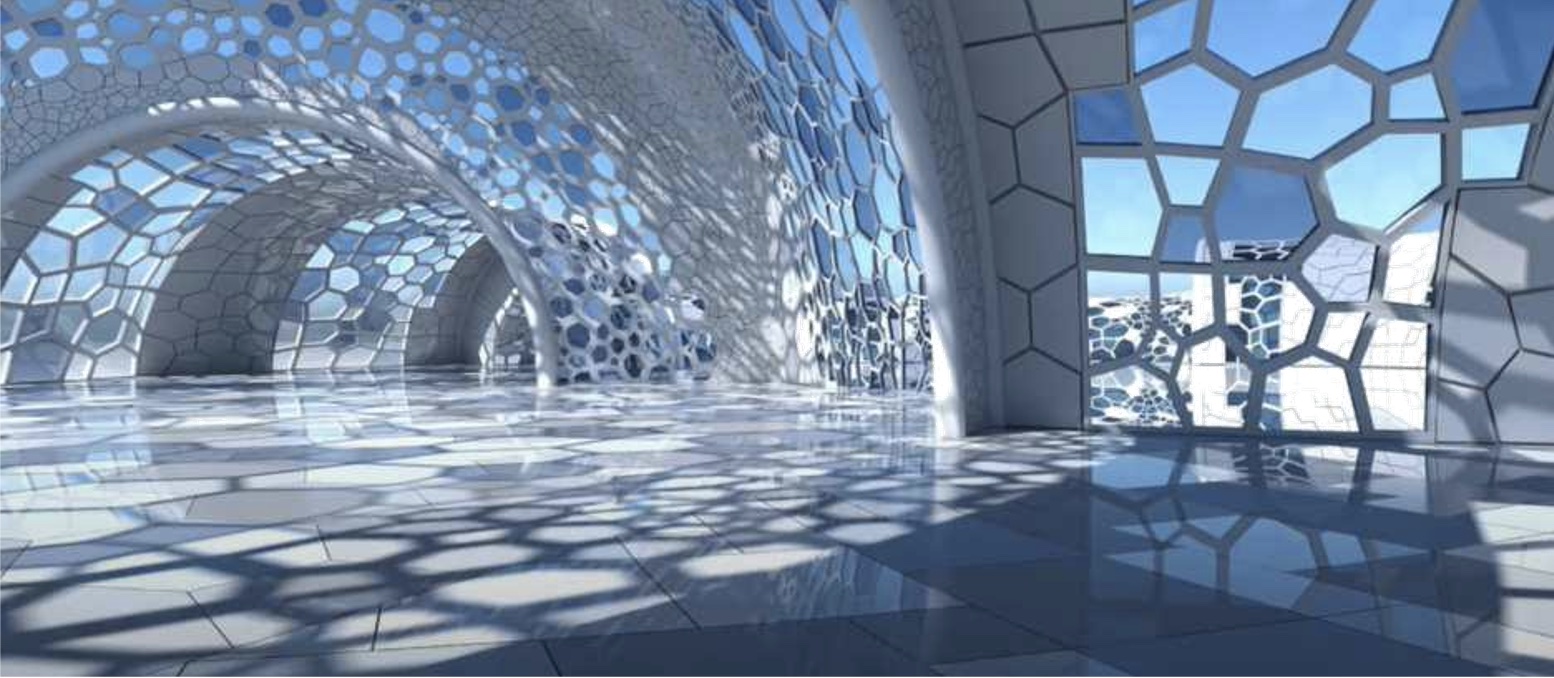
That kind of constructions, as in this image, is seen a lot in Taygeta and Cyndriel. Always connected, especially in public buildings, such as "shopping centers".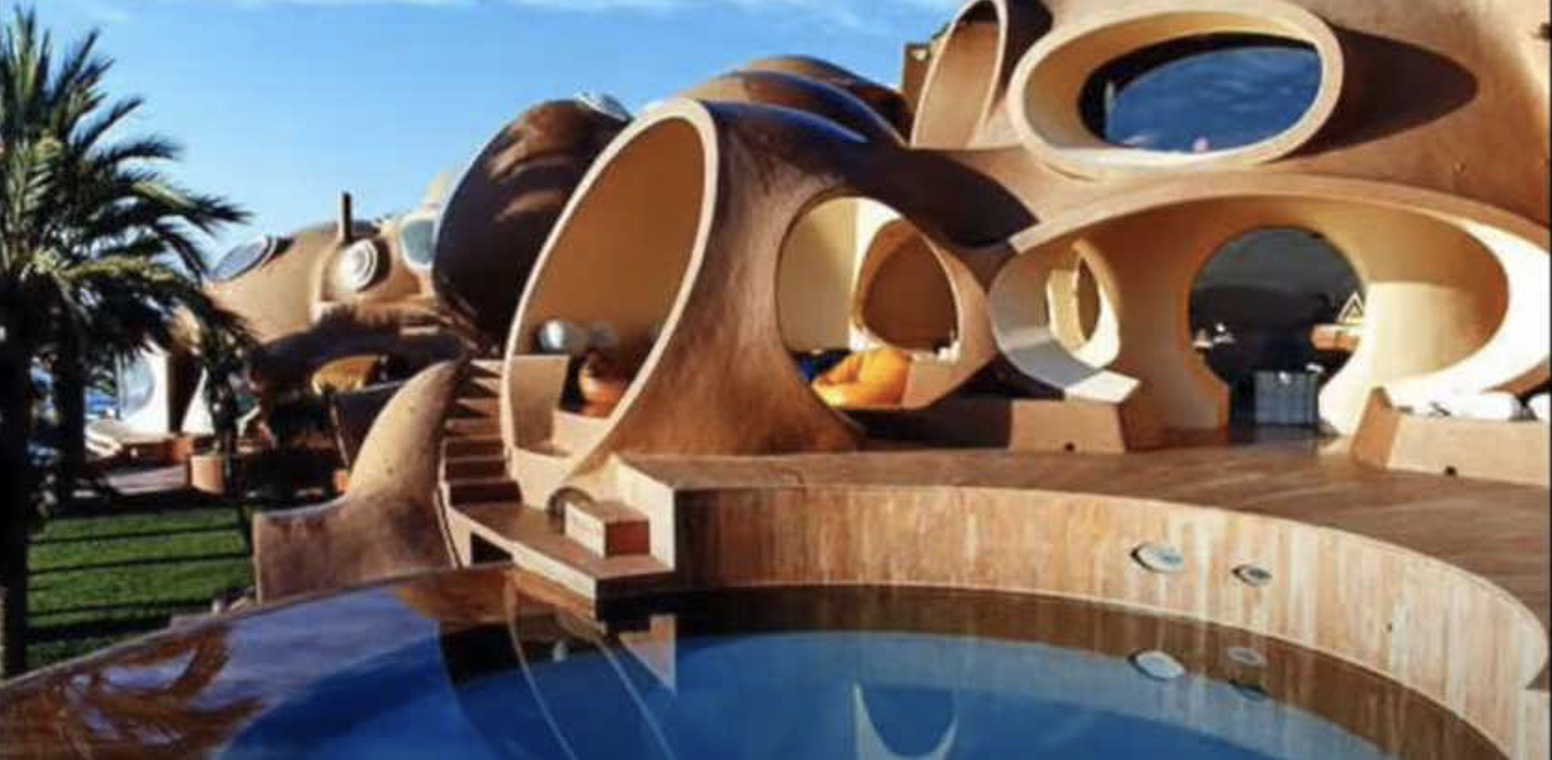
Unlike other more hostile places like Mars, which has 90% or more of the colony buildings below ground, on Cyndriel that is not only unimportant, but would defeat the purpose of visiting the planet as it is all about being outside enjoying a strange, beautiful and unusual landscape.
You can be on the surface there, normal. In itself, the environment is less hostile than on Earth. There's a lot of oxygen. But it does give you a very strong dreamy feeling, like being in an unreal world, like something done by computer immersion, but real. It affects you like what I would describe as that euphoric feeling you get on a high mountain. That's why the strange landscape favors introspection and with it mystical experiences.
The radiation doesn't affect you. It is mild. It doesn't burn you unless you are outside for many hours. I guess that's why a lot of little animals wear armor. And the frequency of solar radiation is higher too. It's not that there's no radiation, there is and a lot of it, but it's very high frequency, high densities, I would describe it that way.
As for farming, agriculture in Cyndriel is under earth, with special equipment like the one used on large ships. In contrast, farming on Taygeta is external, traditional. In the ships they are carried out on special agronomy decks with simulated solar radiation, with special lamps and irrigation systems with variable soil fertilization according to the crops. However, the use of aquaponics systems is common in large ships. Like this, in many occasions, as in this image.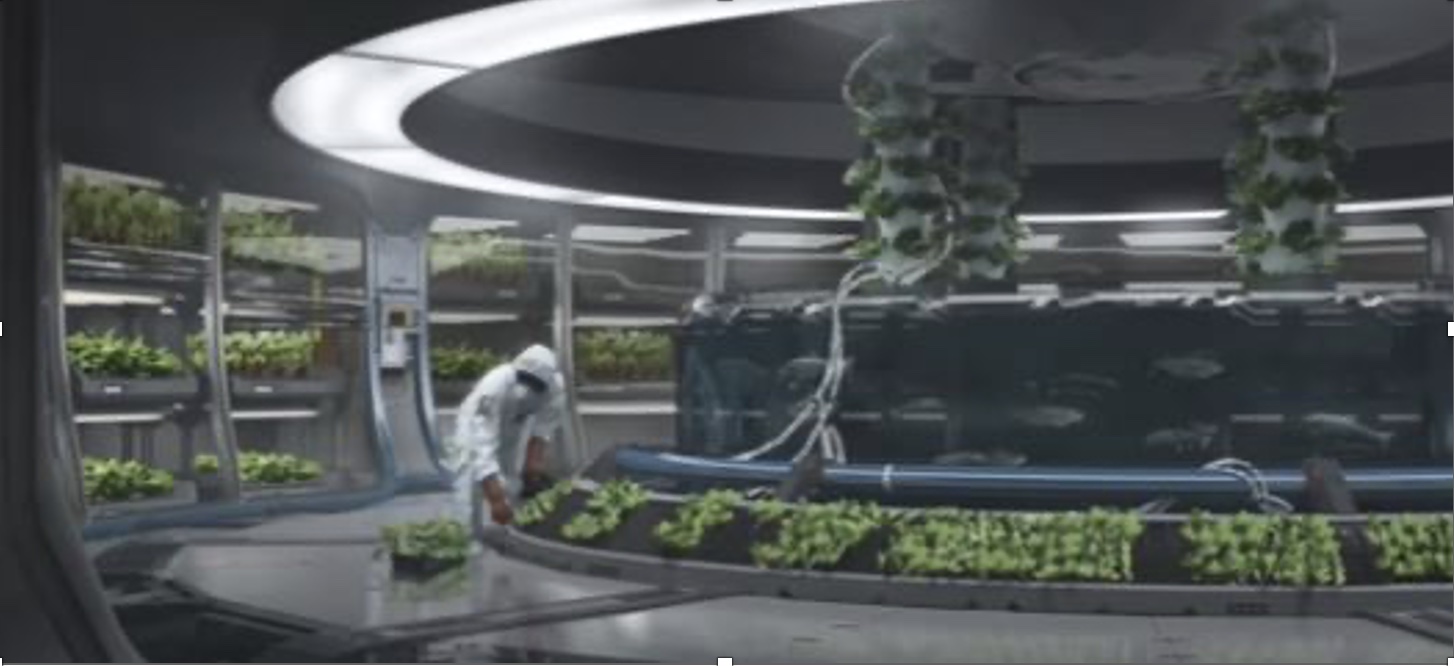
Although there are edible plants in Cyndriel, we must bring and cultivate our own species to sustain a correct diet for our organism. That is why it is done underground with systems comparable to those used in large ships to have control over the type of radiation and plant cycles of day and night, and not to be invasive with the outside or with the biology of Cyndriel, as it could be unintentionally introducing a plant that unbalances the local ecosystem.
Cyndriel is very exotic to the Taygetan mind. Even the Nazis wanted to go there for answers. They said it was the birthplace of the Aryan race as our appearance clearly denotes. We are all like that, that's why they related it. And because of the influence of what the Vril girls who were there with them were telling them. From Rashell's team, from 1919 to 1945. With a plan to stop the Second World War. But as Yazhi says, they were more conducive to it happening.
In addition to esoteric reasons from ancient texts including Celtic, Sumerian and Egyptian, which indicated to the Nazis the idea of the origin of the Aryan race in Aldebaran. This because, according to those ancient records corroborated by Rashell, they say that the Anunnaki come from there, Nordic Aryans, us. Also Engan and to a lesser degree Solatians as these are too white.
Cyndriel is a dream. A lot of silence there. It lends itself to introspection. Everything seems to be unreal, mystical, dreamlike. That is why the Taygetan colony of Aldebaran has survived. The only one that exists outside Taygeta without counting temporary minor bases, of course, because those were even on Earth.
This transcript is available for download
file_downloadDownload as PDF file_downloadDownload as TEXTCommunity provided translations
| Language | Author | Updated | Action |
|---|---|---|---|
| 繁體中文 | Wendy YouTube» | November 07, 2023 | file_downloadPDF |
